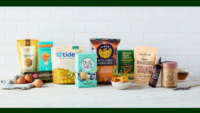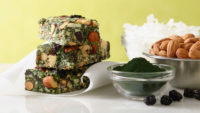FlavorSum: Top Trends, Tastes for 2023
FlavorSum ready to help translate next year’s top trends to new taste opportunities

PHOTO COURTESY OF: FlavorSum
FlavorSum is pleased to share part one of our two-part series on food and beverage predictions for 2023. In this article, FlavorSum showcases the trending consumer habits and market trends in store for 2023. In part two, FlavorSum will look at upcoming flavor and taste trends.
Instead of adjusting to a “new normal” like many of us hoped, 2022 was a year filled with a complex set of worries, both old and new. In addition to now-familiar concerns like COVID, health, and climate change, geopolitical conflicts and rising inflation have added to the heightened sense of unpredictability.
Trend Hunter predicts 2023 will be a period of “incremental chaos” as people make up for time lost during the pandemic and competitors reveal new products. During continued uncertainty, brands have opportunities to offer food and beverage choices that help people find their footing, support mental health, and reach lifestyle and sustainability goals.
USING FOOD TO NOURISH MIND, BODY
More of us are experiencing anxiety (the body’s response to stress) in our daily lives. This “anxiety culture” is more than fear associated with developing issues according to Michael Schapira, Ph.D., adjunct professor of philosophy at Saint Joseph’s University, Philadelphia. Schapira notes that anxiety culture “has become characteristic of our dealing with the increasing problems and undefined solutions of a rapidly changing world.”
How can food play a role in alleviating anxiety? Global consumers are turning to food and beverage choices to improve their mental and emotional well-being. We can expect to see a continued focus on stress relief and mood-boosting ingredients across nearly all food and beverage categories. Other health-related benefits like brain health, gut health, and immune support will also be important.
Stand-Out Statistics
-
In the US, almost half of consumers (49%) experienced stress in the 12 months, while nearly two-fifths (38%) dealt with anxiety (Mintel).
-
Nutritional benefits are a top five driver for consumers when it comes to food (Innova).
-
Brain health is outpacing overall active claims in food and beverage, growing at 12% CAGR ending in Q1 2022 vs 4% for other active health claims (Innova).
With 36% of consumers believing functional food and beverages can improve or enhance mood (Innova), interest in mood-boosting botanicals like mushrooms and hemp is rising. Ashwagandha is currently the most frequent botanical in mood-boosting positionings, Lion’s mane is the top functional mushroom, and saffron remains the fastest growing herb or spice (Innova).
Other botanicals to watch:
-
Bacopa – for memory and anxiety support (+95.6% CAGR over the last five years)
-
Maca – for anxiety, stress, and depression support (+74.6%)
-
Lemon balm – for sleep, anxiety, and appetite support (+73.4%)
Functional Beverages
According to Precedence Research, the $129.3 billion global functional beverages market could grow at an 8.94% CAGR from 2022 to 2030. And interest is rising. According to a FlavorSum proprietary study, 56% of US adults are looking for purposeful beverages.
We expect to see more fermented drink options like kombucha and kefir on store shelves. Brand Essence research predicts kombucha sales will deliver a 15% CAGR, surpassing $2 billion in North America by 2027. Technavio estimates North American kefir sales will reach almost $900 million by 2026 on a growth rate of almost 8% compounded annually.
People are learning more about the gut-brain axis, and we anticipate brands will provide education supporting health claims like gut health, immune support, and improved vitamin and mineral absorption.
INTERSECTION OF FOOD AND TECHNOLOGY
Technology is becoming a more influential part of cooking and shopping. We search for new recipes on TikTok and Pinterest. Then, we talk to smart devices in our kitchens that can start the grocery list and have appliances that connect with recipe apps to automatically adjust cooking temperatures.
Stand-Out Statistics
-
Americans are cooking 51% more often compared to pre-pandemic levels. They’re also baking 34% more (Hunter).
-
Individuals are 5 times more likely to use a recipe they found on social media versus recipes they saw on TV (Social Chain).
-
The worldwide smart kitchen appliances industry is worth an estimated $13.18 billion (Grand View Research)
Social Media Influence
Platforms like TikTok and Pinterest have helped many people feel more confident trying new recipes at home. Popular dishes or globally-inspired flavors with millions of views have a real-world impact. In early 2021, a popular TikTok pasta recipe caused feta cheese shortages in U.S. grocery stores. The relationship between the digital and “real” food worlds will continue to deepen, and brands that are part of the conversation will create stronger connections.
Online Shopping
While online grocery shopping picked up during the pandemic, the relationship between in-store and online is complex. Over the last 12 months, the proportion of Americans who say they have purchased groceries online declined. But slightly more people say they now do “most” or “almost all” of their grocery shopping online (Food Navigator).
With inflation rising and grocery budgets not stretching as far, we may see increases in pre-shop planning and online shopping to cut down on unplanned or impulsive purchases. For brands, the shift away from impulse means getting innovation news out digitally (and on the right channels) vs in-store.
GLOBAL CONSCIOUSNESS
Awareness of global issues is expanding, and more people are making conscious food and beverage choices. Whether selecting a plant-based option or looking for upcycled ingredients, shoppers will continue looking for foods and beverages that align with their sustainability and environmental goals.
Stand-Out Statistics
- 70% of U.S. teens say that their sustainable actions can make a difference, while 56% worry about climate change (Mintel).
-
56% of adults in Canada consider food waste when purchasing food and drink in stores (Mintel).
-
About 90% of plant-based food consumers aren’t vegetarian or vegan (NPD Group).
Inflation Awareness
Unfortunately, inflation is expected to stay above the Federal Reserve’s goal of 2% in 2023. As rising prices take their toll on household finances, shoppers will look for ways to economize their grocery budgets. According to Mintel, saving strategies will include finding value through bundling and deals (52%), reduced dining-out (39%), choosing store brands (36%), store switching (31%), and brand changes (17%).
Plant-Based Options
Even though some people will be willing to forgo purchases, others are still willing to pay a premium for sustainable options. Most shoppers buying plant-based options make the choice for health and environmental reasons. Some health benefits associated with plant-based foods include reducing inflammation and reducing the risk of cancer and diabetes. Parents who wish to pass their sustainability convictions to the next generation will look for kid-friendly plant-based options like non-dairy pudding pouches and cheese sticks.
NEW FORMATS
Forbes recently reported that 79% of Americans prefer personalized service that helps them feel seen, heard, and valued. Brands are responding with tactics like social media feeds based on hobbies and interests, meal delivery kits with weekly options, and personal styling services. People are also tailoring food and drink choices to fit their habits and goals, seeking a custom eating experience in and out of home. New formats like low- or no-alcohol beverages and inclusions like CBD can fill this desire for customization.
Stand-Out Statistics
- *58% of global consumers are drinking more non-alcoholic and low-ABV cocktails than a year ago (2022 Bacardi Cocktail Trends Report).
- No- and low-alcohol volume will grow by 8% CAGR between 2021 and 2025, compared to regular alcohol volume growth of 0.7% CAGR during that same period (IWSR Drinks Market Analysis).
- The CBD category is forecasted to reach $23.6 billion by 2025 (Grand View Research).
Low/No Alcohol
The idea of “mindful consumption” takes inspiration from popular mental health and wellness practices. Innova reports that one-third of consumers aged 18-25 are now saying that they never consume alcohol. We expect the moderation trend will continue as people prioritize mental health and clarity and as the quality of low- or no-alcohol choices improves.
CBD Drinks
Some people are exploring how CBD can help in their daily lives by reducing stress and pain or promoting sleep. Beverages fit well with the CBD category because of their versatility and portability. The U.S. CBD drinks market is expected to grow by 65% in 2023 and reach a value of around $657 million as more brands enter the market and states approve the ingredient (BevNet). Canada’s current regulatory environment limits purchase of cannabis-infused beverages to five cans per purchase, but brands are anticipating an easing of the limit in 2023. As more products become available, continued education and transparency will be important for building trust and brand loyalty.
Will Your Next Food & Beverage Innovation Be On Trend?
What’s your next opportunity for innovation? Whether you’re looking for marketing insights or help with formulation, FlavorSum is here with the expertise to help you create great-tasting products that align with consumer needs and inspire brand loyalty. Contact us to talk about getting the support you need!
Looking for a reprint of this article?
From high-res PDFs to custom plaques, order your copy today!





